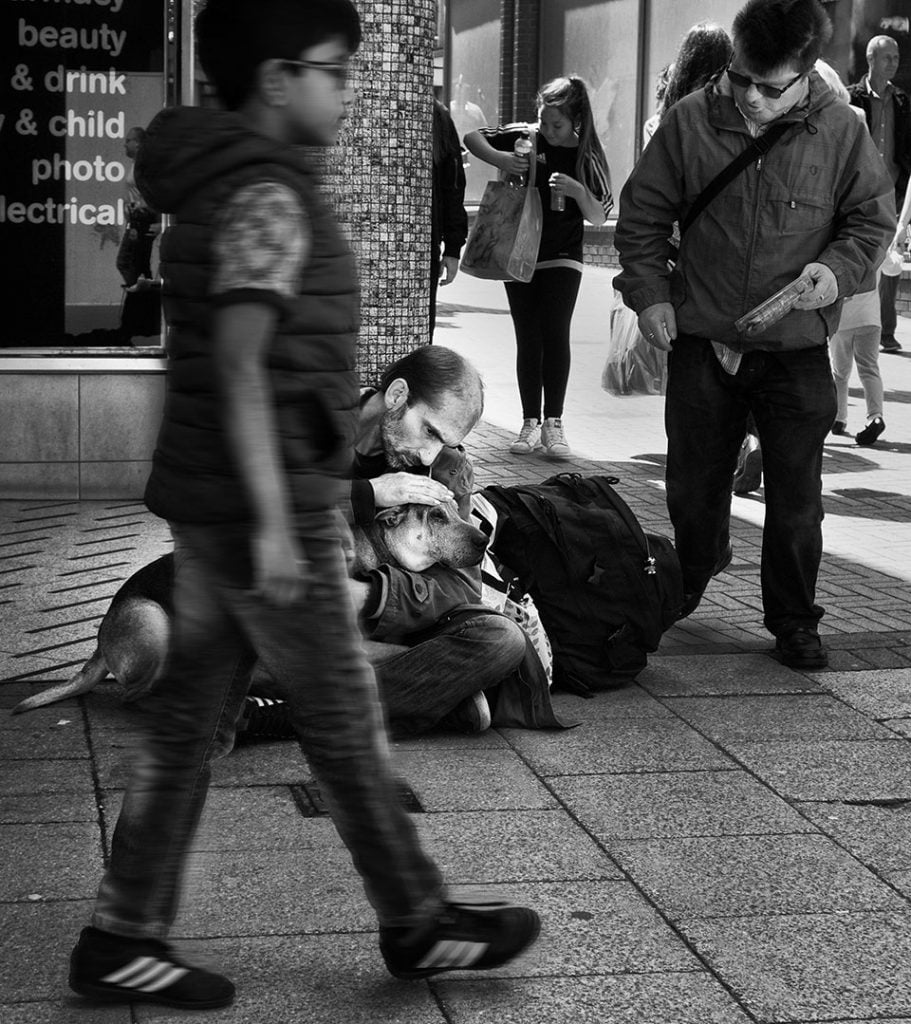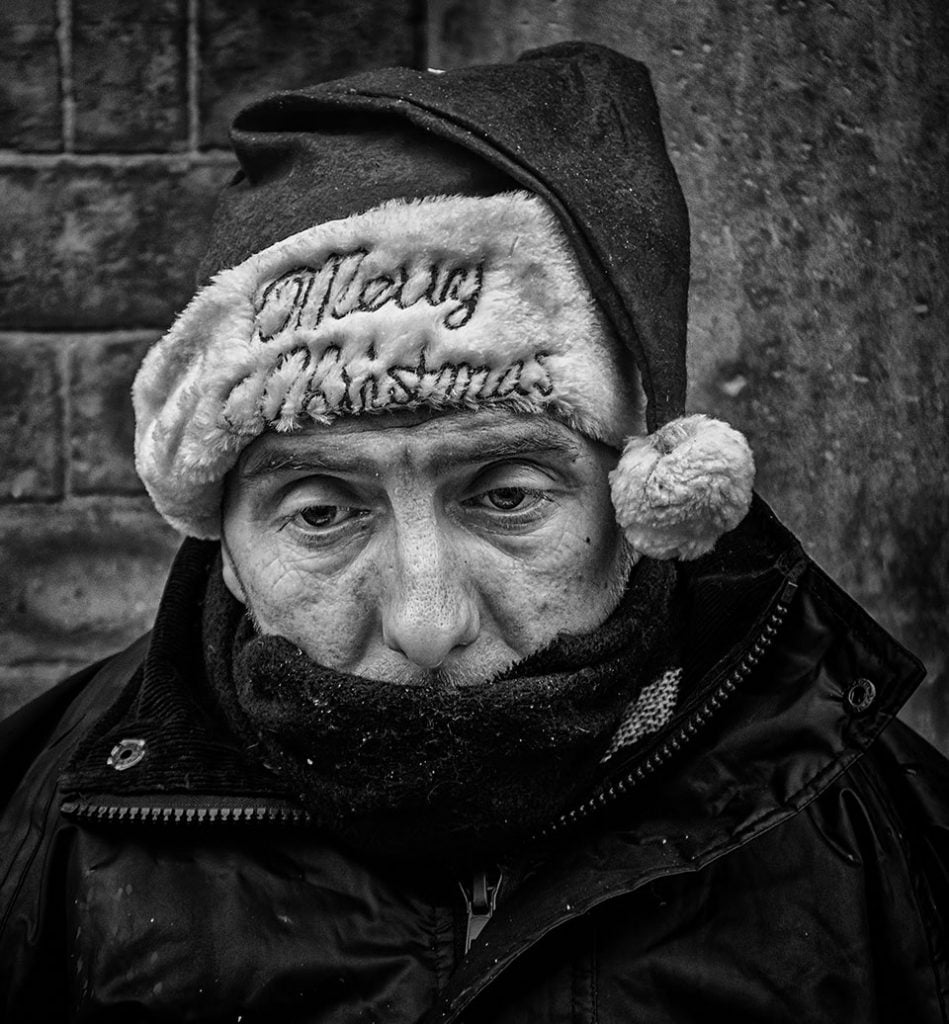A few thoughts on photographing the homeless

I’ve often seen the argument that street photographers shouldn’t photograph the homeless.
The reasoning seems to roughly come down to three things:
- It’s too easy.
- It’s exploitative.
- All street photography is wrong.
The ‘easy option’
The ‘they’re too easy a target’ seems to come primarily from street photography ‘experts’ on the web. I use the term ‘expert’ in this sense to refer to those running photography blogs rather than those who are ‘photographers’. They tend to do articles along the lines of ’10 mistakes street photographers make’ or ’10 things great photographers never do’. Invariably photographing the homeless is one of them.
Whilst I can see a logic in this argument I think it’s far too simplistic.
I don’t really see documentary and street photography in purist terms. They might be an ‘easy target’ in some ways but not all photography has to be an exercise in technique and following some arbitrary set of rules.
In some ways, of course, they could be classed as ‘easier’. They tend to be stationary and their appearance might conform to some preconceived idea of what is interesting or photogenic. So yes; easy to photograph and instantly effective results. It is also cliched. Perhaps it is the cliche that the ‘experts’ should advise against.
To photograph a ‘cliched’ subject and make it relevant is far from easy.
I think the argument against photographing the homeless has some validity if the photographer only photographs the homeless. Unless done as part of a specific project, possibly made in liaison with charities working in the field, then I’m not sure if it can really be classed as street photography. For me, a wide range of ‘street subjects’ should be shown.
To have a blanket rule saying no homeless I think is unnecessarily restrictive in a photographic sense and could even be seen as bordering on discrimination.
Unfortunately, there is a real and increasing homeless problem that is inexcusable in wealthy countries. Government cutbacks and a widespread apathy in the general population must shoulder a large part of the responsibility.
To not photograph them does not make the problem any less real and there is a valid argument that their plight should be shown. I don’t believe that photography has the same power to impact on the collective social conscience it may once have done, but I still think it has a role in highlighting social issues.
Everyone is aware that homelessness exists without needing a photograph to prove the fact. However, sometimes uncomfortable topics need to be kept in people’s minds. Here photography may still have a role.
If a street photography portfolio consists disproportionately of this type of image then maybe there is a case to answer. If they appear alongside a larger more varied body of work, however, and are done sympathetically then I think it is a valid area of photography.
I have photographs of homeless people on this site and the After the Coal Dust website. Hopefully, I have not included an excessive amount. Personally I try and show the human aspect. I don’t want it to be just another record shot. Hopefully, the image conveys just a tiny fraction of what it feels like to be in their predicament.
Homeless people are a section of society just like any other. If a photographer wants to realistically reflect life today then, unfortunately, the homeless need to be part of it.

Rhyl, North Wales 2018
‘Poverty Porn’
There are some people who vehemently maintain they should not be photographed. It’s ‘poverty porn’ and the photographer is exploiting the weakest in society for a few likes on social media. In some cases they are right. There are some photographers who indeed treat the homeless in this way. I still believe, however, that it is possible to do so respectfully and responsibly.
Some of those who complain about photographs of the homeless are often against photographs of other groups (the overweight, the elderly for example) – in many cases, they are against street photography altogether. The photographer will always experience negativity from these no matter how well-intentioned they are. I’ve even been criticised for posting pictures of ‘homeless people’ when the person in the photo was anything but.
There is a level of hypocrisy at play from some of the critics. The person who attacks a photographer for depicting a grim reality at home is quite willing to do the same when on their foreign holidays; happy to give a pittance to a street beggar for a quick snap on their iPhone.
Worst of all are those that attack the homeless themselves for being homeless. They trot out arguments that it must be their own fault, that they are alcoholics or drug addicts, that they should get a job and so on. Every circumstance is unique. It’s a fine line between being comfortable and losing everything. Illness, losing a job, divorce, debt – one day it could be us.
On a personal level, I take very few pictures of the homeless. Out of several hundred pictures taken for the ‘100 faces’ series of candid street portraits there are maybe only two or three homeless people. In the general street photos probably less than 1%. I hope I haven’t exploited anyone. There have been many times when I’ve thought about taking a picture but decided against, partly for some of the reasons above. When I do press the shutter I hope I can show an aspect of the human condition sympathetically.
Photography won’t solve the problem but I believe a documentary photographer has the right, and even an obligation, to show some images people might prefer not to see. if it is done with the right intentions and a degree of empathy they should keep photographing.
To sum up, I accept that photographing the homeless can be the easy option (although not if it is done well) and that if it is exploitative it is no more so than any other street photography. It would be wrong, however, to exclude a growing section of society from street and documentary photography. Maybe ‘street photography’ is not the correct term, perhaps ‘humanist photography’ would be more appropriate.
Not taking a picture does not make it go away. If a photograph can bring home the human cost of the issue then it is worthwhile.
Homelessness is not a photography problem. It is society’s problem and it is a poor reflection of that society that it exists at all. We are wealthy enough to eradicate it – we just need the will.

He gave his approval for the photo.

I agree there shouldn’t be any turning away from any aspect of humanity when it comes to street photography. The overall purpose is to document ‘real’ life, and homeless people are both real, and alive. They wouldn’t be in their situation if the society they belonged to had more compassion, and photography, as you put it, “sometimes uncomfortable topics need to be kept in people’s minds.”
No editing option available, so I will make my correction here: I agree there shouldn’t be any turning away from any aspect of humanity when it comes to street photography. The overall purpose is to document ‘real’ life, and homeless people are both real, and alive. They wouldn’t be in their situation if the society they belonged to had more compassion, and photography, as you put it, is valuable in that it reminds the public that “sometimes uncomfortable topics need to be kept in people’s minds.”
Thanks Rob,
Sorry about the lack of an edit. I have to manually approve any comments before they appear. It’s a pain but otherwise all sort of crap would show (apparently loads of Russian women are just dying to meet me!) 🙂
why aren’t the same folks who claim to be defending the homeless from photographers also spending time volunteering at soap kitchens and shelters?
As a photographer and former homeless person I do find these topics interesting.
I guess the key points from my point of view is where you see a homeless person that is their home. How would you feel if someone came into your home and started to take photos of you?
if you have the correct reasons for taking the photographs that is fine. Do though respect privacy. Ask before taking the photo you may end up getting better photos as a result.
Chris
https://christopherjameshall.co.uk
https://narratorslens.org
It’s a very interesting topic that divides opinion but I think Mr Gill deserves a lot of credit for being open and raising the subject.
I was fortunate to attend one of his presentations a few years ago and he spoke very eloquently on the subject of photographing people on the street and was very receptive to having an open debate with the audience on the subject. Personally, I am sure that Mr Gill has a very sympathetic eye in his photography and feel that his intentions are genuine. Talking openly about sensitive topics is very important and using photography to stimulate the conversation is very worthwhile.
I’m not sure how many images were shown in the presentation, (perhaps a hundred or so), and I only recall one or two pictures of homeless people so it’s important to not take it out of context.
As I say, however, it is good to stimulate discussion.
I’m not sure I agree that he would get better results by asking, personally I love the photographs.
Anna
Pingback: FMP Part 2 – proposal – Site Title
Gabby
If I can help your project in any way please let me know 🙂
John
“Ask before taking the photo you may end up getting better photos as a result.”
This sounds like a dig at the photographer’s ability – that’s uncalled for. Irrespective of one’s views on the subject, I don’t thank the quality is in doubt.